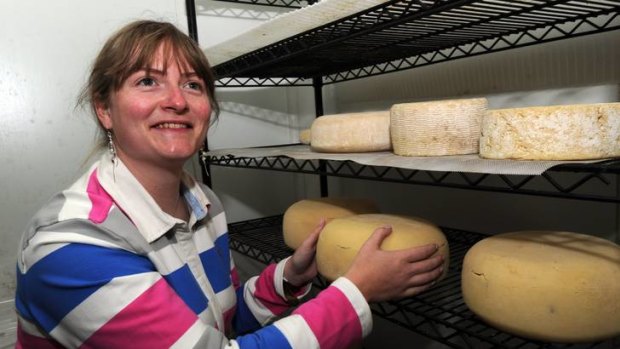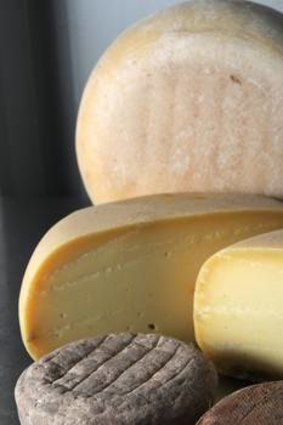By Larissa Nicholson
Judy and Vanessa Bradley have never had cheesemaking lessons but still managed to impress the judges at this year's Sydney Royal Cheese and Dairy Produce Show. The mother-and-daughter team from Thistledown Creamery brought home two gold medals, for their Tin Sheep Tomme, a hard, French-style cheese made with sheep's milk; and for their sheep's milk yoghurt. They also won silver for their marinated estrella, a creamy cheese.
The Tomme also just won champion non-bovine cheese at the Dairy Industry Association of Australia competition in Melbourne. Not a bad effort given it was only three years ago the Bradleys got a commercial licence for their dairy business.

Dairy queen ... Vanessa Bradley of Thistledown Creamery.Credit: Graham Tidy
Judy has been on the land for 38 years, and runs 2000 merino sheep on the family property in Windellama, in the southern tablelands of NSW. It was daughter Vanessa who became interested in dairy sheep when she was 16.
She bought a few ewes and started milking them, then tried making cheese. It's is not your average teenage hobby, but Judy wasn't surprised when Vanessa took it up. ''She was never going to be an average, run-of-the-mill person,'' Judy says.

Ewe's milk cheese from Thistledown Creamery.Credit: Graham Tidy
Nine years later, the pair has close to 200 dairy sheep. Judy milks the ewes morning and evening, while Vanessa makes the cheese. Most of Thistledown Creamery's products are made using milk from sheep reared on site. ''It's really hard work, and it's expensive to run a sheep dairy,'' Vanessa says.
The average ewe gives about a litre of milk a day, so it's time-intensive, too, but Judy is convinced the results are worth it.
When the Bradleys started a decade ago, they were the only sheep dairy in NSW. Lack of expertise in the region meant Vanessa taught herself how to make sheep's milk cheese almost entirely by trial and error. She sought advice from cheesemakers in the US, then just kept trying until she got it right. It's a seasonal pastime - the ewes produce milk only from June to January.
Vanessa works on her own in a tiny cheesemaking facility and coolroom next to the farm house. She explains how she makes one of her hard cheeses, called Flicka.
After pasteurising the milk by heating it, she adds culture and lets it sit for about half an hour to ripen. She adds rennet to separate milk into curds and whey, dices the whey into pieces the size of a grain of rice, then stirs it for an hour, and heats it from 35C to about 50C.
After letting the solids settle in the bottom of the vat, she drains away the whey, cuts the curds and jams them into a mould. After the cheese sets, she puts it aside to age.
One of the main differences working with sheep's milk, compared with cow's milk, is the much lower water content, which makes sheep's milk so creamy.
''It's a big, big difference, you don't have to stir it as much, it doesn't need quite as much salt, it doesn't need to be pressed quite as much as cow's [cheese],'' Vanessa says.
Thistledown Creamery will hold an open day on June 10 as part of the Flavours of the South festival in the southern highlands. Visitors will be able to meet some of the dairy sheep and see where the cheese is produced, but because the sheep are not producing milk at the moment, there will only be a limited amount of hard cheese to buy. As Judy says, they never intended to compete with the big, commercial cow dairies. ''When we decided we were making cheese, we were making [seasonal] sheep's milk cheese,'' she says. ''If people want [cheese] all the time they can go to Coles and Woolies.''
For festival details, see highlandsfoodiegroup.com.au.